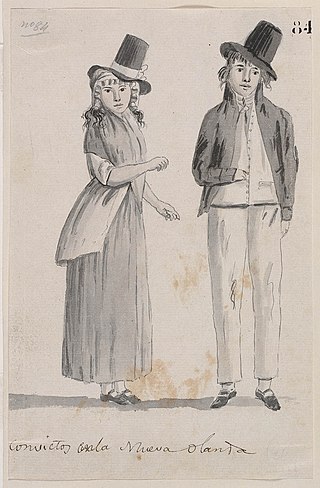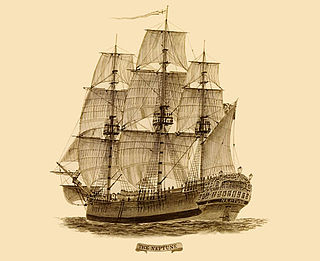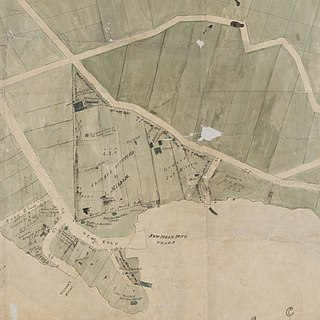
The First Fleet was a fleet of 11 British ships that brought the first British colonists and convicts to Australia. It was made up of two Royal Navy vessels, three store ships and six convict transports. On 13 May 1787 the fleet under the command of Captain Arthur Phillip, with over 1400 people, left from Portsmouth, England and took a journey of over 24,000 kilometres (15,000 mi) and over 250 days to eventually arrive in Botany Bay, New South Wales, where a penal colony would become the first British settlement in Australia.

Scarborough was a double-decked, three-masted, ship-rigged, copper-sheathed, barque that participated in the First Fleet, assigned to transport convicts for the European colonisation of Australia in 1788. Also, the British East India company (EIC) chartered Scarborough to take a cargo of tea back to Britain after her two voyages transporting convicts. She spent much of her career as a West Indiaman, trading between London and the West Indies, but did perform a third voyage in 1801–02 to Bengal for the EIC. In January 1805 she repelled a French privateer of superior force in a single-ship action, before foundering in April.
Friendship was a merchant brig built in Scarborough, England, and launched in 1784. As part of the Australian First Fleet, she transported convicts from England to New South Wales. Due to problems manning her, she was scuttled in the Makassar Strait in October 1788.

Between 1788 and 1868, about 162,000 convicts were transported from Great Britain and Ireland to various penal colonies in Australia.

A convict ship was any ship engaged on a voyage to carry convicted felons under sentence of penal transportation from their place of conviction to their place of exile.

Surry, also known as Surrey, was a square-rigged transport ship, which had an especially long career transporting convicts to Australia. In 11 voyages, the most of any convict transport, she brought 2,177 convicts, male and female, and so became one of the best-known of the vessels that visited Australia. In all, she lost 51 men and one woman during her various passages, 46 of the men dying during her first and most notorious voyage in 1814 when she was under the command of James Patterson. The high death toll on her first voyage led to a Board of Enquiry, which blamed neglect by the Master and Surgeon.
Phoenix was a three-decker merchant ship built on the Thames in 1798. On a voyage in 1824 on which she first transported convicts to Van Diemen's Land she was damaged on the Sow and Pigs Reef inside Port Jackson Heads, New South Wales, Australia. She was then condemned and turned into a prison hulk. She was broken up in 1837.
Minstrel was launched at Hull in 1811. She transported convicts to Australia in 1812 and again in 1825. Between these voyages she traded east of the Cape of Good Hope under a license from the British East India Company (EIC). In 1829 she brought immigrants from England to the Swan River Colony. She then traded widely, including across the Atlantic. Minstrel foundered in March 1851.
Andromeda was built in Sunderland, England in 1819. Initially she made one voyage to India, sailing under a licence from the British East India Company. She then started sailing to Australia, carrying voluntary and involuntary migrants. She made four voyages transporting convicts: one voyage to Van Diemen's Land and three to New South Wales. She continue to trade, primarily to Australia. Her last voyage was to Ichaboe Island. She was last listed in 1847.
HMS Porpoise was the former mercantile quarter-decked sloop Lord Melville, which the Royal Navy purchased in 1804 to use as a store-ship.
Norfolk was built at Littlehampton, England in 1814. She was originally a West Indiaman, and then sailed to India and Quebec. She made four voyages transporting convicts from England to Australia, one voyage from Ireland to Australia and one from Madras and Mauritius to Australia. She was wrecked on 7 July 1837.
HM Colonial brig Kangaroo, was a brig built at Bideford, England in 1811 or 1812. She belonged to the British Royal Navy's Transport Board and was based at Port Jackson. There she made voyages for the colonial government along the east coast of Australia with goods and troops. She made one voyage to Ceylon for merchandise and transporting military convicts from Ceylon to Australia. She returned to England in 1817 and the Navy sold her in 1818.
Hooghly was a full-rigged merchant ship built on the Thames, England, and launched in 1819. She made two voyages under charter to the British East India Company (EIC), four voyages transporting convicts from England and Ireland to Australia, as well as voyages transporting emigrants to South Australia between 1839 and 1856. Around 1858 she was re-rigged as a barque. She sank off Algiers in 1863.
Lotus was a ship launched at Whitby, England in 1826. She made several voyages to Australia carrying emigrants. She made one voyage transporting convicts to Van Diemen's Land. On that voyage, in 1833, she rescued 61 survivors from Hibernia, which a fire had destroyed in the South Atlantic as Hibenia was carrying immigrants to Van Diemen's Land. Lotus herself was lost in May 1844 while sailing between Bristol and Quebec.

Borneo was a merchant ship built in Borneo in 1817. She undertook one convict voyage to Van Diemen's Land in 1828. She was wrecked in 1832 on her first whaling voyage.
Bheemoolah was launched in 1808 at Calcutta as a "country ship", that is a vessel based in India that traded in the region and with China. She made two voyages to England for the British East India Company (EIC), one before her name changed to Woodbridge in 1812, and one after. She spent most of her career trading with the East Indies. The US Navy captured her in 1814 but the British Royal Navy recaptured her within hours. She also made two voyages transporting convicts, one voyage to New South Wales (1839-1840) and one to Van Diemen's Land (1843). She is last listed in 1855.
Competitor was launched at Whitby in 1813. She was initially a West Indiaman and then traded with India. She made two voyages transporting convicts to Australia, one to Van Diemen's Land and one to Port Jackson. She is last listed in 1833.

Morley was a merchantman launched in 1811 at Deptford as a West Indiaman. In 1813 she was under contract to the Transport Board when she captured an American vessel, which capture gave rise to an interesting court case. In early 1815 an American letter of marque captured, plundered, and released her. She then made six voyages to Australia transporting convicts. On her fifth voyage she introduced whooping-cough to Australia. After her sixth voyage she sailed to China and then brought a cargo back to England for the British East India Company (EIC). She continued to sail to Australia and elsewhere and is last listed in 1855.
Barrosa was launched in 1811 at Cossipore. She sailed to England and then made six voyages for the British East India Company (EIC); during this period she also made one voyage carrying immigrants to South Africa. After the EIC gave up its maritime activities in 1833-1834, Barossa became a transport. She made three voyages transporting convicts to Australia. She was lost in 1847, without loss of life, while transporting contract labourers from Madras to Jamaica.






